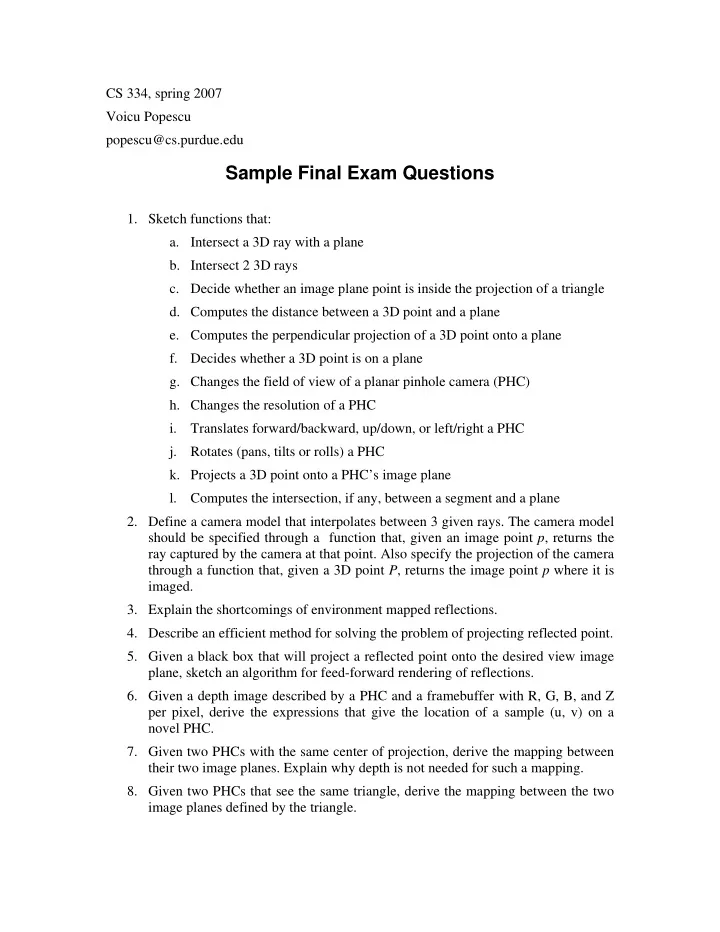

CS 334, spring 2007 Voicu Popescu popescu@cs.purdue.edu Sample Final Exam Questions 1. Sketch functions that: a. Intersect a 3D ray with a plane b. Intersect 2 3D rays c. Decide whether an image plane point is inside the projection of a triangle d. Computes the distance between a 3D point and a plane e. Computes the perpendicular projection of a 3D point onto a plane f. Decides whether a 3D point is on a plane g. Changes the field of view of a planar pinhole camera (PHC) h. Changes the resolution of a PHC i. Translates forward/backward, up/down, or left/right a PHC j. Rotates (pans, tilts or rolls) a PHC k. Projects a 3D point onto a PHC’s image plane l. Computes the intersection, if any, between a segment and a plane 2. Define a camera model that interpolates between 3 given rays. The camera model should be specified through a function that, given an image point p , returns the ray captured by the camera at that point. Also specify the projection of the camera through a function that, given a 3D point P , returns the image point p where it is imaged. 3. Explain the shortcomings of environment mapped reflections. 4. Describe an efficient method for solving the problem of projecting reflected point. 5. Given a black box that will project a reflected point onto the desired view image plane, sketch an algorithm for feed-forward rendering of reflections. 6. Given a depth image described by a PHC and a framebuffer with R, G, B, and Z per pixel, derive the expressions that give the location of a sample (u, v) on a novel PHC. 7. Given two PHCs with the same center of projection, derive the mapping between their two image planes. Explain why depth is not needed for such a mapping. 8. Given two PHCs that see the same triangle, derive the mapping between the two image planes defined by the triangle.
9. An occlusion camera is a non-pinhole with rays that reach around occluders to gather barely hidden samples, defined as samples close to the silhouette of foreground objects, but hidden. These samples become visible for minimum viewpoint translations. Describe a method for rendering soft shadows based on occlusion cameras. A soft shadow is a shadow that gradually transitions from umbra (full shadow) to light, through a penumbra region. 10. We have seen how one can render realistic reflections by approximating the reflected scene with depth image impostors. Describe how one could extend the method to efficiently support self-reflections. An efficient method would not intersect more than a depth image for each reflected ray. 11. Describe an occlusion camera method for compressing rendered video (depth is available per pixel). 12. Given two overlapping images taken with two calibrated PHCs (i.e. you know the intrinsic and extrinsic parameters of each camera, in other words you know each camera’s (a, b, c, C)), describe a system that allows a user to interactively extract depth. Can it be done if the two centers of projection (COP) are the same? Explain. When is the accuracy of the extracted depth greater: when the distance between the COPs (baseline) is small or large? Explain. If large yields better accuracy, why not always have a very large baseline? 13. Describe an occlusion camera approach for rendering motion blur. The motion blur effect is the fuzzy appearance of objects that move quickly in the scene and change position considerably from one frame to the next. 14. What are the shortcomings of reflection rendering using reflected scene billboards? 15. Same question for depth image impostors? 16. Would reflection rendering benefit from occlusion camera impostors for the reflected scene? 17. How can occlusion cameras be used to accelerate rendering on autostereoscopic volumetric displays when the display is seen by a single user? Such a display produces a 3D sculpture of light that replicates the 3D scene. 18. Rendering reflections with depth map impostors relies on simplified rotated depth maps (SRDM) for an efficient intersection between a ray and a depth map. Explain the SRDM method. 19. Describe teaching a computer science concept using a 3D computer game. 20. What are the challenges when rendering from 3D points? How can they be overcome? 21. Given a depth image and a desired view, can one compute the depth image sample (u, v) that maps to a desired view pixel (u o , v o )? Explain? 22. Mip-mapping is a technique for eliminating minification artifacts efficiently. Describe mip-mapping.
23. You are given a high-quality off-line renderer. The algorithms take days to compute an image. You would like to somehow achieve similar quality at interactive rates, by pre-computing the color. How can this be done? What are the challenges? How can they be overcome? 24. Describe an efficient method for detecting the collision between two triangle meshes. 25. Describe your free assignment: problem addressed, its importance, how you solved it, strengths and weaknesses of your technique.
Recommend
More recommend